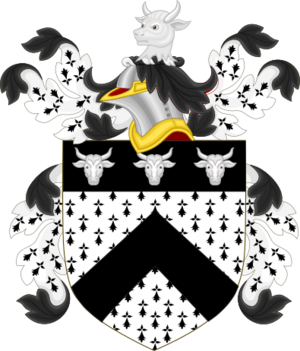Robert Beverley Jr. facts for kids
Quick facts for kids
Robert Beverley Jr.
|
|
|---|---|
| Member of the House of Burgesses for Jamestown | |
| In office 1699–1702 |
|
| Preceded by | Lewis Burwell |
| Succeeded by | Nathaniel Burwell |
| Member of the House of Burgesses for King and Queen County | |
| In office 1720–1720 Serving with George Braxton
|
|
| Preceded by | John Baylor |
| Succeeded by | Richard Johnson |
| Personal details | |
| Born | 1667 Jamestown, Colony of Virginia, British America |
| Died | April 21, 1722 (aged 54–55) King and Queen County, Colony of Virginia, British America |
| Spouse |
Ursula Byrd
(m. 1697) |
| Children | William Beverley |
| Relatives | Robert Beverley(father); Peter Beverley (brother) |
| Known for | History and Present State of Virginia |
Robert Beverley Jr. (born around 1667, died April 21, 1722) was an important person in early colonial Virginia. He was a historian, meaning he wrote about the past. He also owned large farms called plantations and was a politician.
Contents
Robert Beverley Jr.'s Early Life and Family
Robert Beverley Jr. was born in Jamestown. He was the second son of Mary Keeble and her husband, Major Robert Beverley. His father, Major Beverley, came to Virginia from England. He became a clerk for the House of Burgesses, which was like the government assembly.
Major Beverley started one of the most important families in colonial Virginia. Robert had an older half-brother named Peter Beverley. Peter also worked in the House of Burgesses and became its speaker. Robert also had other brothers and sisters.
Robert's father and older full brother died when Robert was young. A guardian, William Churchill, helped manage the family's property. Robert later became the guardian for his younger full brother, John. Robert went to school in England, possibly at Beverley Grammar School.
Becoming a Public Official in Jamestown
Robert Beverley Jr. followed in his father's footsteps. He took on many public jobs and gained influence. He also bought land for plantations. Eventually, he became a member of the House of Burgesses himself.
In 1688, Robert worked as a copyist in Jamestown. He helped the colony's secretary and also worked as a clerk for James City County. Later, his uncle Christopher Robinson became the colony's secretary. He made Robert the clerk of King and Queen County.
Robert continued to work in important government roles. He worked for his half-brother Peter, who was the chief clerk. Robert became clerk for different committees and courts. In 1698, a fire destroyed the statehouse in Jamestown. Robert helped save many important papers.
Serving in the House of Burgesses
In 1699, the people of Jamestown chose Robert Beverley to represent them in the House of Burgesses. He was re-elected in 1700. In 1699, he also joined a group that worked to update the colony's laws.
Robert bought more land in Jamestown and Elizabeth City County. He was appointed to the Elizabeth City County court. However, he faced some legal problems. He traveled to England in 1703 to deal with a court case. While he was away, he lost some of his clerk positions.
Writing About Virginia's History
Robert Beverley's most famous work is his book, History and Present State of Virginia. It was published in London in 1705. This book tells the story of early life in the Virginia colony. It helped people understand the history of the area.
The book was also published in French. Some historians believe these French versions encouraged people to move to Virginia. Robert's book was critical of the governor at the time, Francis Nicholson.
Life as a Planter and Revising Laws
After his trip to England, Robert Beverley returned to Virginia. He became a tobacco planter in King and Queen County. He lived on his plantation called "Beverley Park." He also tried to grow grapes, but it wasn't successful.
In 1719, Robert also invested in an iron foundry. He became friends with the new governor, Alexander Spotswood. Robert likely joined Governor Spotswood on a trip in 1716. This trip was called the "Knights of the Golden Horseshoe Expedition" to the Shenandoah Valley.
Robert also worked on updating the colony's laws. He published a summary of these laws in 1720. He dedicated this book to Governor Spotswood. In 1722, a new edition of his History was published.
Robert Beverley Jr.'s Death and Family Legacy
Robert Beverley Jr. died on April 21, 1722, at his home, Beverley Park. He was buried at the Jamestown Church cemetery. He left a large amount of property to his son.
Robert Beverley Jr.'s Personal Life and Descendants
Robert Beverley Jr. married Ursula Byrd in 1697. Ursula was the daughter of William Byrd I, a well-known planter. Robert and Ursula had one child, Colonel William Beverley (1698–1756).
William Beverley also served in the House of Burgesses. He married Elizabeth Bland. William and Elizabeth had four children. Their son, Robert, married Maria Carter. Maria was the granddaughter of Robert Carter I, a powerful speaker of the House of Burgesses.
The beautiful house called Blandfield was built for William Beverley around 1750. It is one of the largest colonial plantation homes in Virginia. It is now a historic landmark.
Robert and Maria's daughters, Maria and Lucy, married grandsons of Richard Randolph. These families were also related to Pocahontas.


